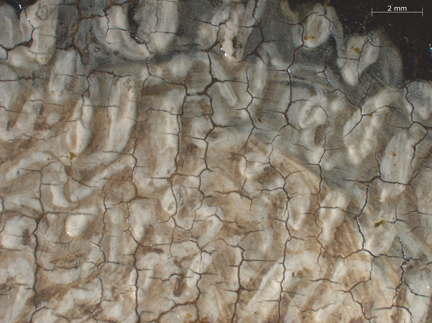
The old theory that Jan van Eyck was the inventor of oil painting has long been disproved. Drying oils had been used as binders for pigments to make paints for centuries before Van Eyck took up his brushes.
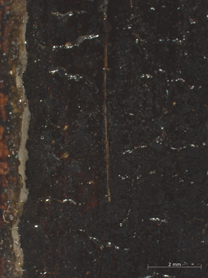
Painting materials
By chance, a hair shed from a paint brush used for Van Eyck's portrait of his wife remains embedded in the black paint at the left edge. Its length (about 6 mm) and colour indicate that it is probably from a fine brush made from the tail fur of a squirrel or a member of the weasel family, much like a modern sable brush.
Heat-bodied linseed oil was identified in all the paint samples that were analysed from the painting and the front frame mouldings. Heat-bodied oils have been partially pre-polymerised (polymerisation is the process by which oil sets or ‘dries’) by gentle heating. Oils could also be placed in a dish exposed to sunlight.1
Paints made with heat-bodied oils form a softly rounded impasto when they contain pigments such as lead white and smooth glossy glazes with translucent pigments such as red lakes and copper greens.
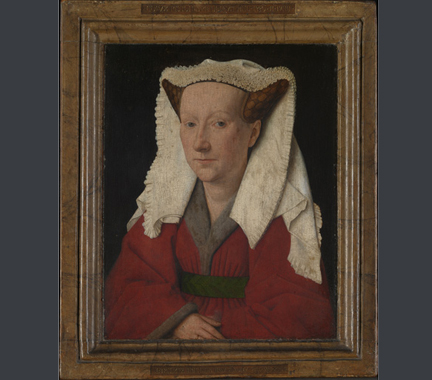
Headdress
Margaret’s complicated white headdress provided a superb vehicle for Van Eyck’s descriptive powers. Close examination demonstrates the speed and virtuosity with which he manipulated his simple painting materials.
Such headdresses, fashionable in Bruges at the time, consisted of a single length of fine linen with ruffled edges introduced as part of the weaving process. The fabric was repeatedly folded back on itself until the edges formed a dense frill. In Margaret’s case seven layers of fabric can be counted. By contrast, Giovanni Arnolfini’s wife in The Arnolfini Portrait, whose head is dressed in similar fashion, has only five.2
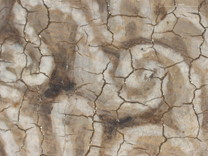
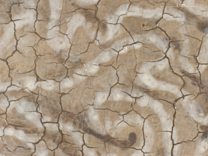
The precision and confidence with which Van Eyck’s brush followed the twists and turns of the edges of the ruffles, sometimes picking them out with short dots of dense white, is astonishing.
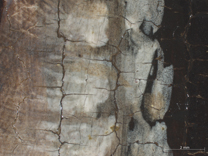
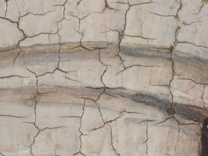
At the right side of the painting, Van Eyck suggested a single thickness of fine linen by bringing touches of white over the black background with deft flicks of the brush. In other places he defined the little pleats of the ruffles by scraping into the soft white paint with a tool, perhaps the end of his paintbrush handle. In the X-radiograph these scraped out lines show as darker than the rest of the white paint (see X-rays and pentimenti).
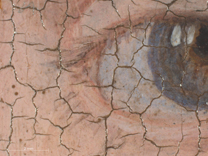
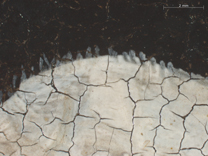
Along the top of the headdress, Van Eyck has taken a small dry brush and dragged the wet white paint up into the black in tiny vertical strokes. These may have been to indicate the softness of the linen but they also soften the contour, making it vibrate. He has used the same short wet-in-wet strokes to blur the edge of the upper lid of Margaret’s right eye.
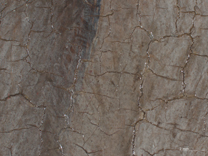
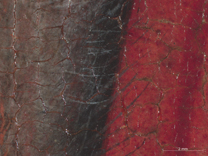
The painting of the soft fur gives the impression of precision but in fact the individual hairs of the pelt are defined only at the edges where the fur overlaps Margaret's dress and neckline.
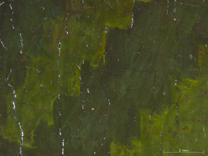

Green sash
Margaret’s rich green sash or girdle is depicted as a silk damask. Its simple pattern suggests that she may have woven it herself. It would have been woven as a single strip and not cut from a larger piece of fabric. Small tablet looms for weaving ribbons and girdles are recorded as having been owned by gentlewomen in the Renaissance.3
Van Eyck has described the belt with his usual confident skill, the rapid flick of his brush evident at the points of the zigzags. It is completed with a rich glaze of copper green pigment, almost certainly in the same heat-bodied linseed oil used for the rest of the painting. Here it has resulted in a smooth glossy surface appropriate for the silk that it represents. This contrasts with the blotting of the final glazes on the scarlet dress, which both ensures an even application and suggests the different texture of the matt woollen fabric.
Next: The speaking image
